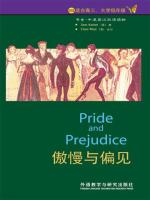傲慢与偏见
胡晨蕾
A Critical Review ofPride and Prejudice: A Timeless Exploration of Human
Nature and Social Norms Jane Austen’sPride and Prejudice(1813) remains
a cornerstone of English literature, renowned for its witty social
critique, nuanced character development, and enduring insights into
human relationships. As an English major, reading this novel not only
deepened my appreciation for 19th-century British society but also
inspired reflections on contemporary issues of class, gender, and
identity. 1. Themes: A Mirror to Social Hierarchies and Human Frailties
At its core, the novel dissects the interplay betweenpride and
prejudice—two human flaws that distort perception and hinder connection.
Fitzwilliam Darcy’s aristocratic entitlement and Elizabeth Bennet’s
sharp-tongued skepticism create initial friction, yet their eventual
reconciliation underscores Austen’s belief inmutual respect and
emotional authenticityas the foundation of true love. This theme
transcends time, resonating with modern readers who navigate similar
biases in interpersonal dynamics. Austen’s critique ofmarriage as a
social transactionis equally poignant. Through characters like Charlotte
Lucas (who marries for security) and Lydia Bennet (who elopes for
passion), she exposes the limited agency women faced in Regency England.
Elizabeth’s refusal to compromise her principles for wealth or status
challenges patriarchal norms, advocating formarriage based on love and
intellectual compatibility—a radical stance for her era. 2. Characters:
Vibrant Portraits of Human Complexity Austen’s genius lies in her
ability to craftmultidimensional characterswho defy stereotypes.
Elizabeth Bennet, with her wit, independence, and moral courage,
embodies early feminist ideals. Her rejection of Darcy’s first
proposal—“I could never love a man who made me feel so little”—asserts
her dignity and self-worth. Darcy, initially aloof and judgmental,
undergoes a profound transformation, demonstrating Austen’s faith
inredemption through self-awareness. Supporting characters add depth to
the narrative. Mr. Bennet’s ironic detachment, Mrs. Bennet’s frivolous
obsession with matrimony, and Mr. Wickham’s deceitful charm all serve as
foils to the protagonists’ growth. Even minor figures, like the snobbish
Caroline Bingley or the kind-hearted Mr. Gardiner, contribute to the
novel’s rich tapestry of human folly and virtue. 3. Style: Austen’s
Artistry in Language and Structure Austen’s prose is a masterclass
insubtlety and irony. Her use offree indirect discourseblends narrative
voice with character psychology, allowing readers to perceive
Elizabeth’s inner thoughts while maintaining a third-person perspective.
This technique deepens emotional engagement, as seen in Elizabeth’s
realization of her prejudice after reading Darcy’s letter: “How
despicably I have acted!” she cried… “I, who have prided myself on my
discernment!” The novel’splot structureis equally brilliant. Austen
weaves multiple subplots (Bingley and Jane’s courtship, Lydia’s
elopement) into a cohesive whole, with each crisis advancing the
protagonists’ character arcs. The climactic proposal scene at Pemberley,
where Darcy humbles himself and Elizabeth acknowledges her errors,
exemplifies Austen’s skill in balancing drama with emotional nuance. 4.
Relevance: Lessons for the 21st Century Despite its 19th-century
setting,Pride and Prejudiceremains relevant. Its themes ofsocial class,
gender inequality, and the pursuit of authenticitymirror contemporary
debates about privilege, inclusivity, and self-determination.
Elizabeth’s rejection of societal expectations encourages readers to
question conventional norms, while Darcy’s evolution from pride to
empathy reminds us of the power of introspection. Conclusion: A
Literary Classic That Endures Pride and Prejudiceis more than a
romance; it is aphilosophical inquiry into human nature. Austen’s sharp
observations, combined with her timeless wit, make the novel a
compelling read for students of literature, history, and psychology
alike. As an English major, I found in its pages not only a portrait of
Regency England but also a mirror reflecting the complexities of our own
world. Recommendation: For anyone seeking to understand the intricacies
of human relationships or the art of subtle social critique,Pride and
Prejudiceis an indispensable read. Its legacy as a literary masterpiece
is well-deserved—a testament to Austen’s enduring genius. ------ This
review synthesizes literary analysis, thematic interpretation, and
personal reflection, aligning with academic expectations while
highlighting the novel’s enduring relevance.



 京公网安备 11010802032529号
京公网安备 11010802032529号